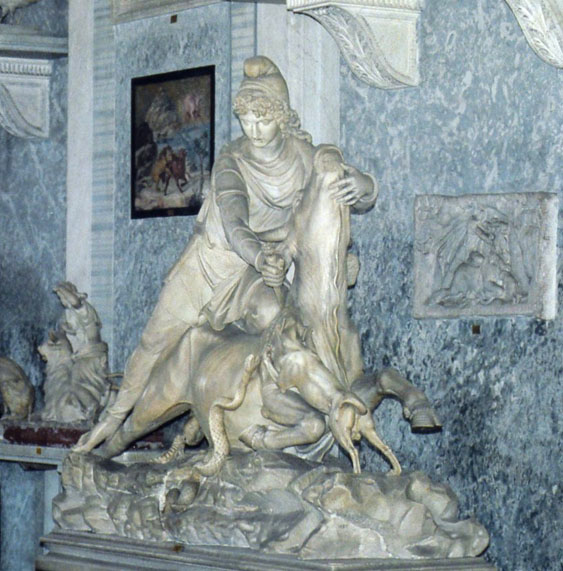 *Photo taken by DanielCD at Wikipedia in March 2004*
*Photo taken by DanielCD at Wikipedia in March 2004*Over to the left, we have a picture of Mithras. Now, you may be saying,
"Who is Mithras?"
Well, I'll be glad to tell you.
Mithras was a Roman god. Here's his story. He was born out of a rock on December 25. He is usually shown carrying a torch in one hand (bringing light), and a dagger in the other. His birth is attended by two shepherds.
Sometime after this, he performs a water miracle. He sits on a stone aiming a bow at a rockface, another person sits a below, waiting to catch water in cupped hands. This of course bears resemblance to the story in Exodus of Moses striking a rock with his staff and water flowing out of it.
As a finale, Mithras hunts and slays a bull in a cave. In some depictions, the bull is shown grazing peacefully, in others he is lying inside a temple. Mithras hunts him and slays him. There is a scorpion attached to the bull's genitals, a dog and a snake are also biting the bull.
It has been reasonably difficult to truly determine the meaning of these depictions, as Mithraists left no holy texts, neither have they left behind many captions underneath these images. These images and monuments are all found in caves which were used as temples. Mithraists worshipped in caves because that's where the sacred scene of Mithras slaying the bull took place.
What does this have to do with Christianity? Not very much unless you listen to Leigh Teabing in Dan Brown's book, "The DaVinci Code." Teabing says in Chapter 55 of "the DaVinci Code", "Don't get a symbologist started on Christian icons. Nothing in Christianity is original. The pre-Christian God Mithras - called the Son of God and the Light of the World - was born on December 25, died, was buried in a rock tomb, and then is resurrected in three days."
I've decided to do some research on our good old friend Mithras, and I'm going to share what I've found. It seems actual Mithraic scholars (you know, people who actually spend their careers researching Mithras) don't really agree very much with Teabing. Let me break down the specific points.
"Pre-Christian"....true, but needs a SERIOUS qualification. Mithras was actually originally a Persian deity who first surfaces around 1400 BC. The thing is scholars have found no common link at all between the Persian Mithras and the Roman Mithras (other than the name of the God) who was being worshipped close to the same time Christianity was also being practiced in Rome. But it's fair to point out that the earliest evidence for Mithraism in Rome comes from the late first century, which makes it post-Christian. The Persian Mithras never slew a bull, he was a mediator of contracts, which the Roman Mithras never did.
"Called the Son of God and the Light of the World" - JP Holding says on his site (link below) that he found no evidence for this...neither did I. Let's move on.
"Born on December 25" - as noted above, this is true. However, there's no parallel here between Mithras and Christ, because Jesus WASN'T born on December 25. There is not a single mention of December 25 as Jesus' birthday in the New Testament. None. This was something adopted by the Christian church in the fourth century, therefore there was no borrowing originally from the Mithras cult.
"Died, was buried in a rock tomb, and then is resurrected." - I think the following quotes speak for themselves.
There is "no death of Mithras – which means, there can be no burial of Mithras, and no resurrection of Mithras, either." ("Image and Value in the Greco-Roman World", Richard Gordon, Variorum, pg. 96)
"The 'unconquered' Mithras, however, does not die and therefore cannot rise again; so Mithraic 'salvation', whether locative or utopian, cannot rest on a story of this sort, nor can its rituals express that type of myth or realize that type of salvation." ("Beck on Mithraism:Collected works with new essays", Roger Beck, Ashgate Publishing, 2004, pg.86-87)
"The (Mithraic) mysteries cannot be shown to have developed from Persian religious ideas, nor does it make sense to interpret them as a fore-runner to Christianity. Both views neglect the sheer creativity that give rise to the mystery cult." ("The Roman Cult of Mithras: The God and his Mysteries", Manfred Clauss, translated by Richard Gordon, Routledge, New York, pg. 7)
But what about Mithras' birth? It was attended by shepherds, right? Well. Mithraic scholar Richard Gordon puts it thusly,
"There are, incidentally, no grounds for calling these two figures 'shepherds', in the wake of the Christian nativity story."(Clauss, pg. 69). These shepherds are little more active in Mithras' birth, because they help pull Mithras out of the rock. I guess you could still call the birth of Mithras a virgin birth though, I can't imagine the rock had much sexual experience beforehand :).
So what is the point of all this? The point is that people will pull out any ancient God they can think of and try to draw parallels to the Christian story, and a good example of this is in Dan Brown's "DaVinci Code". The antidote to all this merry mythmaking for any Christian is a trip to the library.
The second point is if you see someone trying to draw parallels between a pagan God and Christ, CHECK THEIR SOURCES! If the sources are outdated, or if they don't list their sources at all (like Dan Brown), then you shouldn't trust anything they say about early Christianity any farther then you can throw a Sumo wrestler, which, if you're like me, isn't very far at all.
An excellent essay on Mithras can be found here:http://www.tektonics.org/copycat/mithra.html
No comments:
Post a Comment